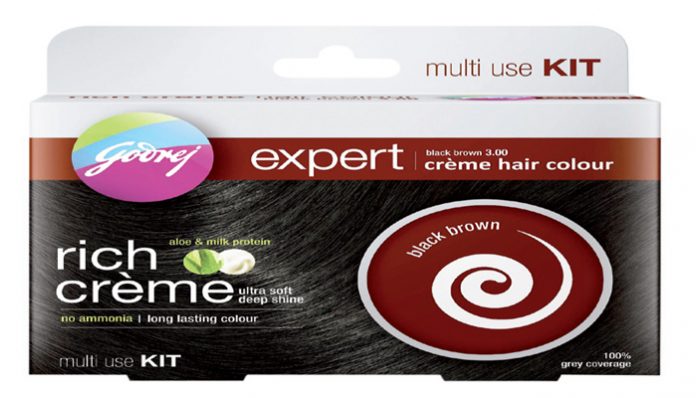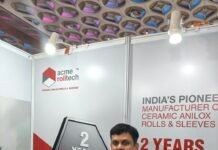While 7, 8 and even 10-color gravure and flexo presses have been used in India for flexible packaging and labels, more than 6-color plus coater presses have only just started being used for carton printing. Until a couple of years ago, a 6-color plus coater was the standard monocarton press. The higher configuration presses including interdeck and end-of-press UV were imported for printing on metalized polyester laminated to paperboard and also sometimes for printing on transparent or translucent plastic substrates.
In the past two years a large number of 7-color presses and a few that are 8-color and even longer presses have been imported by carton printers. In some cases these longer presses were installed in order to accommodate in-line foilers that were mounted across the first two units – leaving the other units for C,M,Y,K and special or brand colors.
 Printing with a fixed set 7-color inks really started with Pragati in Hyderabad importing two new Komori 7-color presses for printing shade cards for a paint company. This was accomplished (as I have written earlier) by using Esko’s Equinox software for the color separations. Subsequently, new 7 and 8-color presses with coaters from Heidelberg, KBA, Komori and RMGT have been installed around the country for printing on cartons.
Printing with a fixed set 7-color inks really started with Pragati in Hyderabad importing two new Komori 7-color presses for printing shade cards for a paint company. This was accomplished (as I have written earlier) by using Esko’s Equinox software for the color separations. Subsequently, new 7 and 8-color presses with coaters from Heidelberg, KBA, Komori and RMGT have been installed around the country for printing on cartons.
However, when in the past two years I asked some of the leading carton printers about their reasons for purchasing 7 and 8-color presses, (apart from the need for more units in the case of adding an in-line foiler), they were not too interested in using a fixed set of 7 color inks to expand the gamut on their presses. They were not keen to deviate from the usual scheme of C,Y,M, K and special color inks for matching brand and Pantone colors. Even at seminars where extended gamut printing was presented, there was little interest or interaction – perhaps because most serious printers who understand extended gamut printing know that while it can give a huge competitive edge, it also requires best practices, calibration and standardization of a fairly high order to be put into place.
Now that several Indian carton printers have already imported and installed 7 and 8-color presses, the concept of extended gamut printing using a fixed set of C,M,Y,K plus Orange, Green and Violet inks is starting to catch their imagination. And it is here, that Heidelberg has an opportunity to gain some traction amongst its long press customers because its Prinect prepress software already contains all the important packaging modules such as trapping and imposition as well as color management and Multicolor – its 7-color solution.
Speaking to Heidelberg India’s general manager prepress Ashokan, who is based in Mumbai, it becomes clear that this is not just a product or software. According to him it is a prepress and Print Color Management activity where Heidelberg can supply the hardware, software, consumables and local expertise and know-how to help its customers optimise the use of their 7-color presses.
print color management activity
Ashokan is clear that a well maintained prepress department is needed for Multicolour 7-color implementation. In his view a thermal CtP is essential (because of its precise and binary output) and it would be easiest for Multicolor implementation if it was a Heidelberg CtP with a Prinect RIP. This is because there is some complexity of screening angles and combinations of AM and FM screening techniques needed for 7-color separations and his experts are most familiar with Heidelberg hardward and Prinect RIP.

He adds that calibration and profiling of the press is key and of course it requires a well maintained press. However, when put into practice, the Multicolor separations have great predictability and the Delta E for a given or desired spot color is forecast for the 7-color profile of a particular press by the software with precision. The Delta E forecast can be compared to what would be the result using the conventional approach of C,M,Y,K with a special color as well. At this stage, users need to deliberate and make a considered decision — since the fixed 7-color setup may not work or be the most desirable path.
In the end, Ashokan says this new technique needs to be learned and mastered. It is analogous to the techniques that the new digital inkjet presses and even some of the older drum and toner digital presses use. Digital presses will not support an infinite set of Pantone or special color inks and it is not likely that a printer will change the inks for a brand color on a digital press. This is also why many of the new sheetfed ink jet presses aimed at high quality and packaging print including the Heidelberg Primefire use a 7-color ink set.
In the past two years, a large number of 7-color presses and a few that are 8-color and even longer presses have been imported by carton printers. In some cases these
longer presses were installed in order to accommodate in-line foilers that were mounted across the first two units – leaving the other units for C,M,Y,K and special or brand colors.
Ink formulation moves from the ink kitchen to the prepress
We also spoke to Ganesh Kumar, Heidelberg India’s senior sales and product manager and a FOGRA certified color management professional who is helping Heidelberg customers achieve standardization and ISO 12647-2 certification. He says that the Prinect Multicolor module has been used for a long time for halftone images and now the company wants to extend it to the use of spot colors and brand colors. While for photographic or halftone images and effects, Multicolor uses relative colorimetric rendering intent, Kumar explains that for spot colors, absolute colormetric rendering intent is needed.
Multicolor analyses the file automatically to deliver a combination of relative and absolute colorimetric rendering intent automatically – depending on the halftone and linework content of the file. For creating a Multicolor separation, a final print-ready file – let’s say a PDF/X-3 file, is simply put it into the Multicolor plug-in for Acrobat Pro which will result in a set of separations based on the user’s profiles. The Delta E values or deviations will be shown in comparison to the target values and there is also the possibility within Multicolor to edit or fine tune the recipe for a particularly desired flavor or taste in color.
Kumar says, “We have tried all this with Indian printers and with Multicolor we can achieve 95% of the Pantone colors with the standard 7-color set and profile. Other difficult colors can be achieved by changing one or more of the inks and creating new profiles – for instance by replacing violet with rhodamine blue and producing a new profile.” Heidelberg India is ready and able with Multicolor to move the ink formulation activity from the ink kitchen that is in every major carton printer, to the prepress department – to a print color management activity for the complete production workflow. z
The author is a G7 Expert and an offset printer with hands-on experience in running sheetfed and web offset presses. You can reach him at editor@ippgroup.in.











